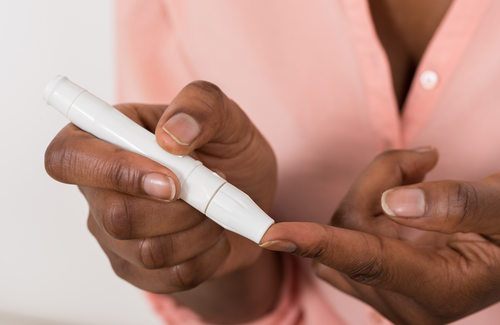
Integrase inhibitors increase the risk of developing type 2 diabetes regardless of how much weight is gained while taking one, a large international cohort study has found.
People with HIV taking an integrase inhibitor as part of their HIV treatment had a 48% higher risk of developing type 2 diabetes. More research is needed to understand the mechanism that raises diabetes risk in people taking integrase inihibitors, say researchers who carried out an international cohort study to look at the relationship between HIV treatment, weight gain and diabetes.
However, they also found that non-treatment-related factors influenced the risk of developing diabetes in over 20,000 people with HIV studied in Europe and Australia. People with CD4 counts below 200 had more than twice the risk of developing diabetes compared to people with CD4 counts above 350. Black people and people of other ethnicities had an approximately 80% higher risk of developing diabetes compared to White people.
Type 2 diabetes is strongly related to increased body fat mass, although the levels of body fat and the distribution of body fat associated with diabetes risk vary by ethnicity. Asian and South Asian people have a higher risk of developing diabetes at a lower body mass index compared to White people, and African Americans, Black Africans and people of African Caribbean heritage have higher diabetes risks than White people too.
Older age, high blood pressure and high cholesterol levels are also risk factors for diabetes.
Dhanushi Rupasinghe, an epidemiologist at the Kirby Institute, University of New South Wales, presented an analysis of the relationship between weight gain on antiretroviral treatment and diabetes risk in people with HIV by the RESPOND cohort study, on the final day of the 12th International AIDS Society Conference on HIV Science (IAS 2023) in Brisbane.
The RESPOND study combines data from 19 cohorts of people with HIV receiving treatment in Europe and Australia.
Cohort members were eligible to join the study if they had baseline CD4 and viral load measurements and at least three body mass measurements during the follow-up period. The study followed people from January 2012, or whenever they joined a cohort after that date, until December 2019. Participants ceased to be included in the analysis after they developed diabetes. People with diabetes at baseline were excluded from the analysis.
"Although integrase inhibitors raised the risk of diabetes, the absolute number of additional cases was small."
The study included 20,865 people, followed for a median of 4.8 years. The median age of cohort members was 45 at baseline, 74% were male, 73% were White, the median CD4 count was 551 and 77% had undetectable viral load at the beginning of follow-up. The median body mass index was 24 and the median glucose level was 5.1 mol/l.
During the follow-up period, 4% of participants developed diabetes, defined as either a blood glucose measurement above 11.1mmol/l, or HbA1c above 6.5% or 48mmol/l, or the use of antidiabetic medication. The incidence rate was 7.8 cases per 1000 person-years of follow-up.
Four factors were associated with an increased risk of developing diabetes. Black people had a 78% higher risk of developing diabetes than White people, while people of other ethnicities had an 81% higher risk. People with CD4 counts below 200 were 2.24 times more likely to develop diabetes than people with CD4 counts above 350. People with high blood pressure had a 43% higher risk of developing diabetes.
Treatment with an integrase inhibitor raised the risk of diabetes by 48% compared with other antiretroviral drug classes. The risk of diabetes was unaffected by the use of tenofovir disoproxil (TDF) or tenofovir alafenamide (TAF), with or without an integrase inhibitor.
One factor was associated with a lower risk of diabetes: women had a 31% lower risk of developing diabetes than men.
Sensitivity analyses showed that the risk of diabetes rose as body mass index rose during follow-up. They compared the risk at four strata of body mass index (21-23, 23-26, 27-30 and over 30) to the risk at BMI below 21. In people with a body mass index above 30, the risk of developing diabetes was five times higher than in people with a BMI below 21.
The analysis found that although body mass index was strongly associated with diabetes and that the effect became more pronounced in people with obesity (as in the general population), integrase inhibitors exerted an effect on the risk of diabetes that was independent of weight at any weight level.
Sensitivity analysis also showed that integrase inhibitors only raised the risk of diabetes after at least one year of treatment. Furthermore, whereas dolutegravir and raltegravir were associated with increased diabetes risk, other integrase inhibitors were not (28% took elvitegravir, bictegravir or cabotegravir during the follow-up period).
But although integrase inhibitors raised the risk of diabetes, the absolute number of additional cases was small. Three people were estimated to develop diabetes as a result of taking an integrase inhibitor for every 1000 person-years of follow-up in the cohort. A Kaplan-Meier analysis, which plots the probability of developing a condition over time, showed that after five years of exposure, just under 6% of those who had taken an integrase inhibitor developed diabetes compared to just under 4% of those taking a protease inhibitor and less than 3% of people taking a non-nucleoside reverse transcriptase inhibitor.
Further research to understand the mechanism that leads to a higher risk of diabetes when taking integrase inhibitors is needed, the researchers concluded.
Rupasinghe D et al. Integrase strand inhibitors (INSTI)-related changes in BMI and risk of diabetes. 12th IAS Conference on HIV Science, Brisbane, abstract OAB0402, 2023.

